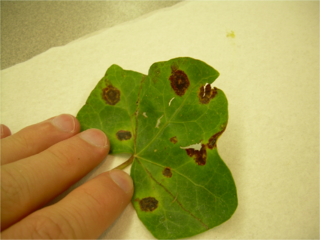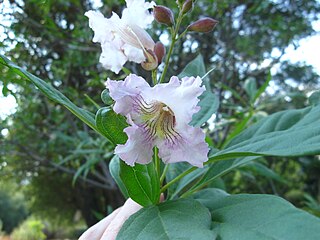This list includes a list of general references, but it lacks sufficient corresponding inline citations .(January 2014) |
The following is a list of diseases of sweetgum ( Liquidambar spp.).
This list includes a list of general references, but it lacks sufficient corresponding inline citations .(January 2014) |
The following is a list of diseases of sweetgum ( Liquidambar spp.).
| Bacterial diseases | |
|---|---|
| Bacterial canker | Bacterium (unidentified) |
| Dieback and leaf scorch | Xylella fastidiosa [1] [2] |
| Miscellaneous diseases and disorders | |
|---|---|
| Leader dieback | unknown cause |
| Sweetgum blight | unknown cause (drought ?)[ citation needed ] |
| Nematodes, parasitic | |
|---|---|
| Lance | |
| Lesion | |
| Root knot | Meloidogyne sp. |
| Sheath | Hemicycliophora sp. |
| Spiral | Helicotylenchus sp. |
| Stubby root | Trichodorus sp. |
| Stunt | Tylenchorynchus sp. |

American sweetgum, also known as American storax, hazel pine, bilsted, redgum, satin-walnut, star-leaved gum, alligatorwood, or simply sweetgum, is a deciduous tree in the genus Liquidambar native to warm temperate areas of eastern North America and tropical montane regions of Mexico and Central America. Sweetgum is one of the main valuable forest trees in the southeastern United States, and is a popular ornamental tree in temperate climates. It is recognizable by the combination of its five-pointed star-shaped leaves and its hard, spiked fruits. It is currently classified in the plant family Altingiaceae, but was formerly considered a member of the Hamamelidaceae.

The Xanthomonadales are a bacterial order within the Gammaproteobacteria. They are one of the largest groups of bacterial phytopathogens, harbouring species such as Xanthomonas citri, Xanthomonas euvesicatoria, Xanthomonas oryzae and Xylella fastidiosa. These bacteria affect agriculturally important plants including tomatoes, bananas, citrus plants, rice, and coffee. Many species within the order are also human pathogens. Species within the genus Stenotrophomonas are multidrug resistant opportunistic pathogens that are responsible for nosocomial infections in immunodeficient patients.

The glassy-winged sharpshooter is a large leafhopper, similar to other species of sharpshooter.
A trade gallon is a unit of volume for standard plant containers in the horticultural industries. It equals 3 US liquid quarts or 0.75 US gallons, although some sources state that a trade gallon equals 2.7 litres (0.71 US gal).

Xylella fastidiosa is an aerobic, Gram-negative bacterium of the genus Xylella. It is a plant pathogen, that grows in the water transport tissues of plants' and is transmitted exclusively by xylem sap-feeding insects such as sharpshooters and spittlebugs. Many plant diseases are due to infections of X. fastidiosa, including bacterial leaf scorch, oleander leaf scorch, coffee leaf scorch (CLS), alfalfa dwarf, phony peach disease, and the economically important Pierce's disease of grapes (PD), olive quick decline syndrome (OQDS), and citrus variegated chlorosis (CVC). While the largest outbreaks of X. fastidiosa–related diseases have occurred in the Americas and Europe, this pathogen has also been found in Taiwan, Israel, and a few other countries worldwide.

The name sharpshooter is used to refer to any of various genera and species of large leafhoppers in the tribe Proconiini of the family Cicadellidae. As with all cicadellids, they have piercing-sucking mouthparts and closely spaced rows of fine spines on their hind legs. The nymphs feed by inserting their needle-like mouthparts into the xylem of the small stems on the plant where the eggs were deposited; the adults have wings and are highly mobile, and most feed on a variety of different plant species. Both nymphs and adults filter a huge volume of dilute liquid through their digestive system to extract the trace nutrients, and much of the water and carbohydrates are squirted forcibly away from the body in a fine stream of droplets, thus earning them their common name.

Artemisia douglasiana, known as California mugwort, Douglas's sagewort, or dream plant, is a western North American species of aromatic herb in the sunflower family.

Graphocephala coccinea is a meadow and woodland-dwelling species of brightly colored leafhopper native to North and Central America, from Canada south to Panama. Common names include candy-striped leafhopper, red-banded leafhopper, scarlet-and-green leafhopper and red-and-blue leafhopper.

Bacterial leaf scorch is a disease state affecting many crops, caused mainly by the xylem-plugging bacterium Xylella fastidiosa. It can be mistaken for ordinary leaf scorch caused by cultural practices such as over-fertilization.

×Chitalpa is an intergeneric hybrid flowering tree in the family Bignoniaceae. There are two major forms in North America, the 'Morning Cloud' a hybrid of desert willow for desert hardiness and color, and northern catalpa, and the 'Pink Dawn' variety formed as a hybrid of desert willow and either yellow catalpa or northern catalpa. Both forms were originally thought to be hybrids of desert willow and southern catalpa. The name is nothogeneric, or a combination of the two parents' names. Leaves are lanceolate, 10 to 13 cm long and 2.5 cm (1 in) wide, almost always in whorls of three. The trumpet-shaped flowers are 2.5 cm (1 in) long and frilly. The inflorescence is indeterminate, with alternately arranged flowers.

Vitis tiliifolia is a New World liana in the grape family commonly known as Caribbean grape. Other names include West Indian grape, water vine, Agrá and Bejuco de Agua and water tie-tie and water-wise.

Philaenus spumarius, the meadow froghopper or meadow spittlebug, is a species of insect belonging to the spittlebug family Aphrophoridae. In Italy and America, it is economically important as one of the vectors of Pierce's Disease .

Verrallia aucta is a species of fly in the family Pipunculidae. It is found in the Palearctic.

Graphocephala atropunctata, commonly known as the blue-green sharpshooter, is a hemipteran bug endemic to California. It carries the phytopathogenic bacteria Xylella fastidiosa which infects the xylem of grape vines causing die-back – known as Pierce's disease. This leads to loss of productivity and economic damage to the California vineyards.
Verdale-de-l'Hérault is an olive cultivar developed in the department of Hérault, in the southern French region of Occitanie. The fruit produces a sweet oil with a light and fruity aroma of greenery, nuts, and apple, and exhibits no bitterness.

Ascolano is a cold-hardy table variety olive cultivar from the Marche and Tuscany regions of Italy that is also grown in California for olive oil.

Olive quick decline syndrome (OQDS) is a wasting disease of olive trees which causes dieback of the leaves, twigs and branches so that the trees no longer produce crops of olives. The main cause is a strain of the bacterium, Xylella fastidiosa, which is spread by plant-sucking insects such as the meadow froghopper. The bacteria restrict the flow of sap within the tree and so choke its extremities.
Pecan bacterial leaf scorch is a disease of the pecan tree that is common throughout the production regions of the United States caused by the pathogenic bacterium Xylella fastidiosa subsp. multiplex. The pathogen was initially discovered to be coincidentally associated with symptoms of pecan fungal leaf scorch in 1998 and has subsequently been found to be endemic in the southeastern United States, as well as Arizona, California, and New Mexico.

Macugonalia moesta is a species from the genus Macugonalia. The species was originally described by Johan Christian Fabricius in 1803.